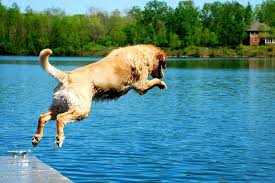Dogs have a thick, warm fur coat. They also sweat to regulate their body temperature.
In some cases, however, panting may not be enough. As a dog’s body heat rises, so do its chances of suffering from heat-related illnesses. Heatstroke can occur in dogs due to hot weather, lack of air, and humidity.
In extreme cases, heatstroke, heat exhaustion, and heat stress can all occur. It is essential to be aware of the symptoms and how to treat this potentially fatal condition.
Here we will discuss how to treat heat stroke in dogs and the signs and symptoms to watch for.
What is Heat Stroke in Dogs?
Dogs that experience heat stress are very thirsty and irritable. Although the dog can move around and is aware of its surroundings, it cannot function properly.
To prevent heat stroke or heat exhaustion, you must cool the dog immediately.
You should note that heatstroke can occur suddenly, and it can happen quickly.
When a dogs’ body temperature rises above 39 degrees Celsius, hypothermia is caused by excessive panting. These dogs can be subject to heat stroke, which is a heat-related illness.
What Causes Heat Stroke in Dogs?
High temperatures and humidity can also cause heatstroke.
 Heatstroke can also be caused by being left out without shade or water during a hot day or left in a car, even with the windows cracked open.
Heatstroke can also be caused by being left out without shade or water during a hot day or left in a car, even with the windows cracked open.
Heatstroke is the most common cause of heat-related diseases in dogs.
Insufficient ventilation can cause dogs to heat up due to their panting.
Heat Stroke vs. Heat Exhaustion in Dogs
Heatstroke: This is the most severe form of hypothermia.
It occurs when the dog’s body temperature rises to dangerously high levels (41.10C or higher).
The dog’s neurological and organ functions begin to fail. Prolonged exposure to heat will increase the chance of organ failure or death.
Heat exhaustion is when the heat stress has reached its extreme.
A dog that has been exposed to heat is usually weak.
Your dog may have trouble moving and could even collapse.
Dogs Can Experience Heat Stroke Symptoms
Heat stroke can lead to complications, including coma and death. Overheating can lead to heat stroke in dogs. It is vital to be attentive to your dog’s needs and recognize signs of heat stroke in your dog so that you can act immediately.
The following are signs of heat stroke, heat stress, heat exhaustion, and overheating in dogs:
- Dehydration
- Weakness, falling down
- Dizziness
- Hyperventilating
- Dry nose
- Drooling
- Shock
- Rapid or irregular heartbeat
- Diarrhea
- Vomiting
- Panting
- Increased body temperature
- Coma
- Dry, pale gums
- Staggering
- Increased thirst
- Bright red tongue
- Stoppage of heartbeat and breathing
- Sticky, thick saliva
- Mental awareness changes
- Seizures
- Production of very little urine or none
- Blood in vomit or stool
- Muscle tremors
Can Dogs Die of Heat Stroke?
Yes, heat stroke in dogs can lead to death. High temperatures can damage cellular structure and organ function, which can lead to irreversible brain damage. It is essential to recognize the signs of heatstroke and overheat in dogs and take steps to cool your dog in hot weather.
How to Help Your Dog if He Gets Heat Stroke
It is essential to cool your dog if he suffers from heat stroke immediately.
 It would be best if you didn’t cool your dog down with ice-cold water. That can lead to other potentially life-threatening medical conditions.
It would be best if you didn’t cool your dog down with ice-cold water. That can lead to other potentially life-threatening medical conditions.
To help your dog cool down after a heat stroke, please follow these steps:
- To increase air circulation and cool him, use a fan.
- Take him out of the heated area immediately.
- Continue to lower your dog’s temperature while you transport him to the vet.
- Maintain a body temperature of 38.3°C to 39.2°C4 and cool off when it reaches the desired temperature.
- Cool water is best for dogs that are still awake. The dog will replace any minerals lost by adding a little salt to the water. However, if the dog is not conscious, you should ensure that no water gets into the nose or mouth.
- Place a damp towel on top.
If My Dog is suffering from Heat Stroke, What Should I Expect at My Vet?
Your vet can assess the severity of your dog’s condition and recommend treatment. All cases of heat stroke in dogs, even suspected cases, should be referred to your veterinarian immediately. The vet can offer any of these options:
- Oxygen therapy
- Intravenous fluids
- Emergency cooling
- Antibiotics
- Intubation of the airway
- Blood tests
- Cardiac medication
- Anti-nausea and gastrointestinal protectants
- Pain medication
- Ventilation
- Transfusion of blood/plasma
How to Keep Your Dog Cool During Summer
Summer is hot and can lead to heat stroke in dogs due to the high temperatures. These tricks will help keep your dog safe and cool in hot weather.
- You can try new games that don’t require too much physical activity, such as puzzle feeder toys and hiding threats.
- Give your dog damp towels, a cooling pad, or a cold tile for your dog to lie on.
- If it’s possible, let your dog enjoy a cool water bath or small body of water. Dog breeds that love to swim and enjoy being in the water are out there. You can use cool water to cool your dog or allow him to swim. That will help keep his body at a healthy temperature.
- Encourage your dog not to be in direct sunlight.
- Use a muzzle with caution.
- Frozen treats
for your dog to cool down. - If necessary, use dog sunscreen.
- Make sure your dog has a lot of water and ice, as well as multiple bowls.
- Turn on the sprinkler and let your dog play in it, or buy them a doggie pool.
How to Prevent Heat Stroke in Dogs
You can prevent heat stroke by keeping your dog in safe surroundings. Dogs can and should be protected from heat stroke. You should be aware of the signs and symptoms so that you can immediately treat your dog if it happens.
To avoid heat stroke in dogs:
- Make sure your dog has a lot of water.
- Do not exercise with your dog at the hottest part of the day. Outdoor activities should be limited to the morning and evening when temperatures are lower.
- You shouldn’t leave a dog in a car, even if it is only for a few minutes or if it is shaded. A parked car can rapidly heat up. Don’t leave your dog in a hot, enclosed area.
- You can keep your dog well-ventilated if you take them along on your trip. Make sure to keep the car cool and often stop to ensure water is always available.
- Shade is essential for dogs when they are outdoors.
- A GPS dog tracker will allow you to know where your dog is at any given moment.
- Avoid walking on surfaces that reflect heat (such as concrete or hot sand).
Conclusion on Heat Stroke in Dogs
Dog owners should know that there are many signs and symptoms of heat stroke in their dogs.
It would help if you cooled your dog off slowly, but not immediately.
If he is still suffering from heat stroke, you should seek immediate veterinary attention. Heat stroke can cause death in the most severe cases.
Heat stroke in dogs can be fatal and can happen instantly if your dog isn’t able to cool down properly.
It could be caused by high temperatures, humidity, or poor air circulation. Heat stroke is more common in certain breeds of dogs and other dogs, such as obese or not being used to hot weather.
Did you find this article useful? Feel free to share your thoughts. We would be happy to hear from you!
Stay tuned for more posts on dog care and much more!
“May Your Home Be Filled With Love And Dog Hair”
Mark
Founder of Our Dogs World 101



Wow! I had no idea this could happen. But it makes sense. I wonder how prevalent it is. All of this is good to know for when we watch our grand dogs. I especially like the idea of giving them frozen dog treats. And knowing when and when not to take them outside. Some of it is common sense, and yet people need to know.
Thanks for your comments Lynn
Hi Mark, heat stroke or heat exhaustion can be very dangerous for dogs (as with humans) and I never realized that high humidity could also cause it. We have very hot summers and our dogs love the cool tiled floor. But we also have a big water tub that they can stand or sit in, to cool down. And they love looking for the shady and damp spots under the shrubs.
Great tip to use a fan to cool the dog down, and also to put a damp towel on their head. Thanks for sharing some great suggestions, as always. Liné
Glad you enjoyed the article and tips Line and thanks for some great comments.
Thanks Mark, sunburn or heat exhaustion
I didn’t think it affected dogs that much.
An uncle of mine had an obese dog and he got tired so fast, he was always upset and barking. No wonder he died soon after, when I took him out, he felt bad and the heat suffocated him.
It’s good to have a tub where the dog can cool down, but I think I have to be taught that first.
And my uncle didn’t have a fan, I think that suffocated him the most.
Respectfully
Vasile,
Thanks Vasile